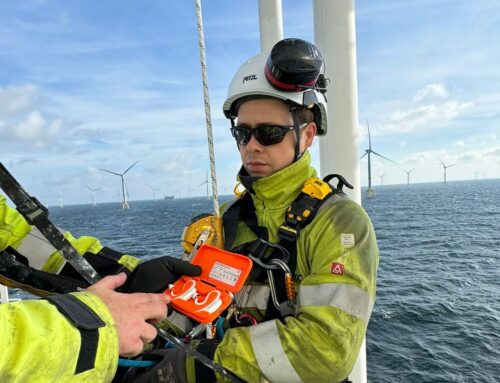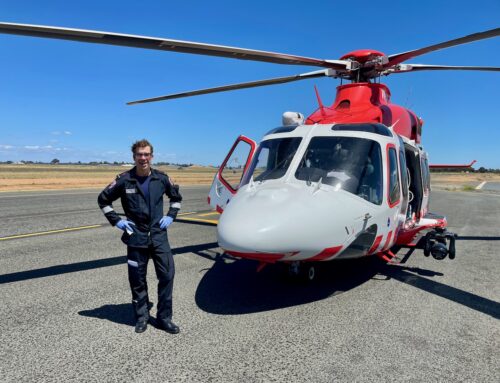How in-ear sensors could revolutionize the diagnosis of sleep disorders
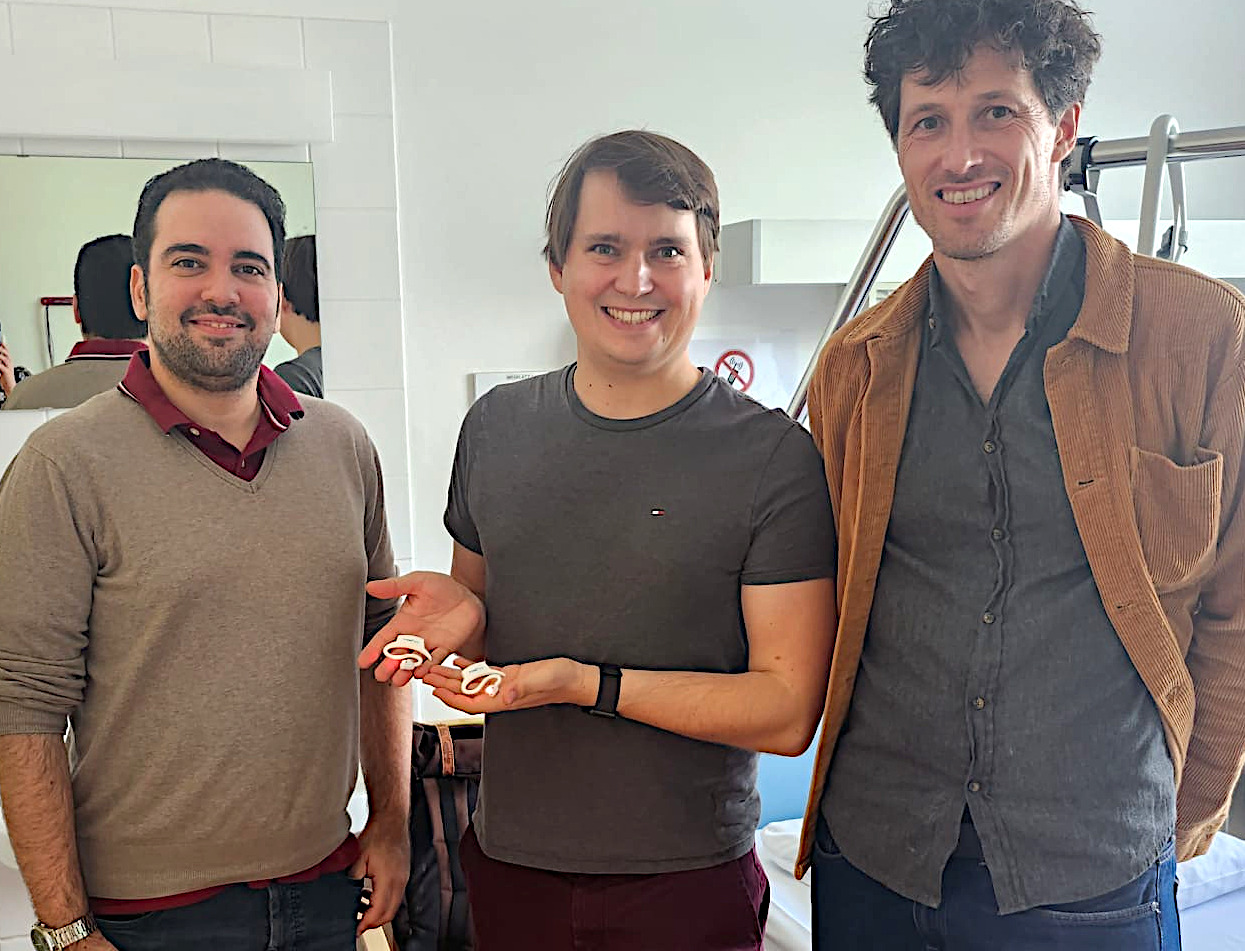
Dr. med. Ilias Masouris, Paul Main (PhD student) with two c-med° alpha in his hands and Dr. Michael Weber (cosinuss°) in the sleep laboratory at Großhadern Hospital.
Around one in three adults suffers from temporary sleep disorders.1 For many, these lead to considerable restrictions in everyday life. However, sleep disorders often go undetected, partly because there is not enough capacity to diagnose them in sleep laboratories. In addition, the current standard examination, polysomnography, is often impaired by various interfering factors, and in the case of certain disorders, such as sleep-wake rhythm disorders, several nights in the sleep laboratory would be necessary for an accurate diagnosis. Research is therefore being carried out into new, simpler methods that can be used at home in familiar surroundings. The use of small, non-invasive in-ear sensors from cosinuss° could be promising. These sensors measure vital parameters such as oxygen saturation and core body temperature, which are important for studying sleep.
Dr. Ilias Masouris, a specialist in neurology at the Großhadern Clinic in Munich, has been researching sleep disorders and their diagnosis using innovative methods for many years. In this interview, he talks about his work and the planned study with the cosinuss° in-ear sensors.
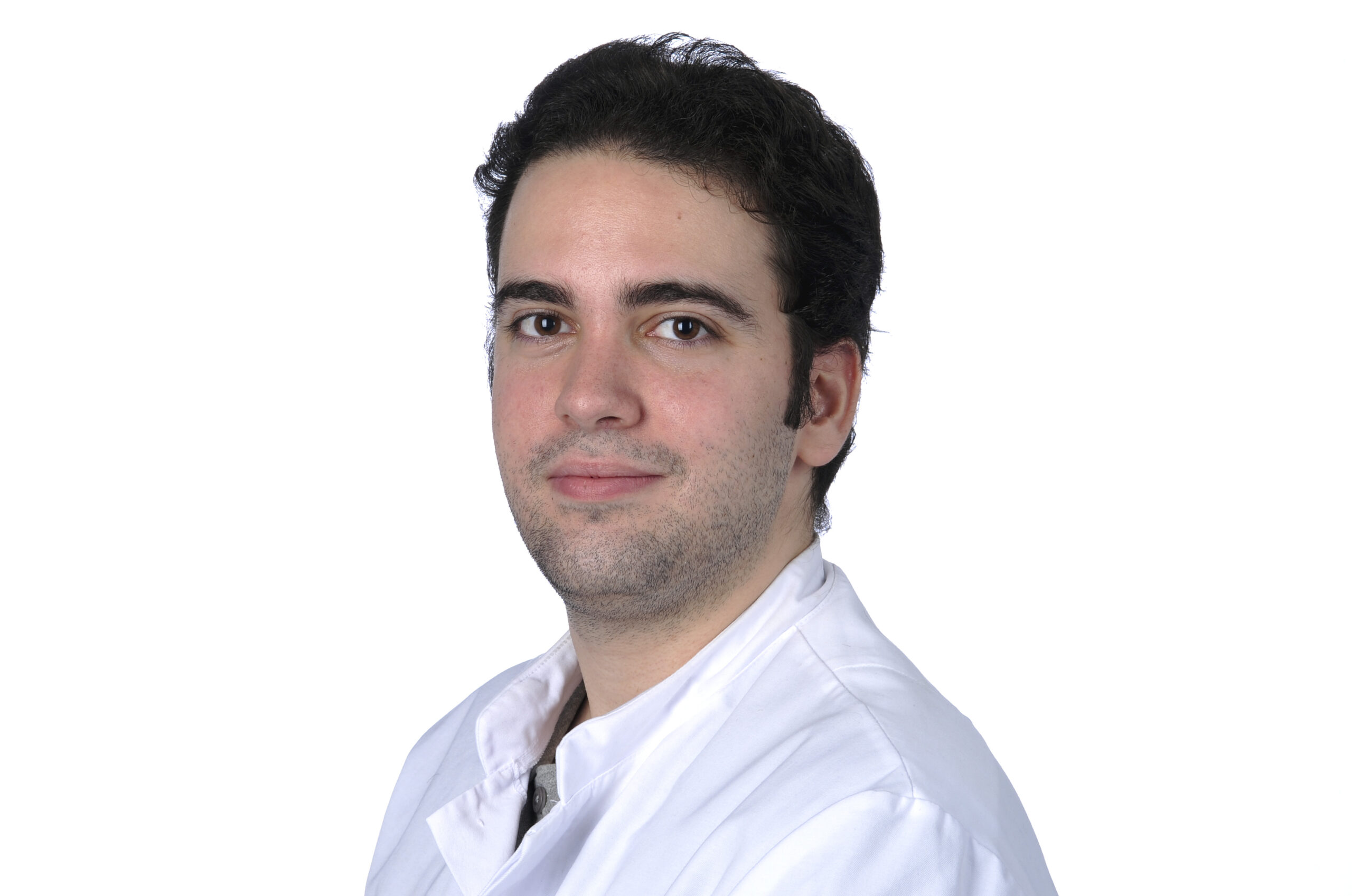
About the interview partner:
Dr. med. Ilias Masouris is a specialist in neurology and a certified DGSM somnologist. He works as a telemedical consultant neurologist in the Neurovascular Network Southwest Bavaria (NEVAS). He specializes in the fields of stroke, neuroinfectiology and sleep medicine.
Dr. Masouris, as a specialist in neurology, you also deal with sleep medicine in addition to neuroinfectiology and strokes. How did this come about?
I come from Athens, Greece. I completed my Abitur at a German school there. I then moved to Munich to study medicine, which I completed at the end of 2013 at Ludwig-Maximilians-Universität (LMU). In February 2014, I started as a junior doctor in the Department of Neurology at Großhadern Hospital. I have now been a specialist in neurology for two and a half years. During my time at the university hospital, I joined the neuroinfectiology group, which has remained a main research focus to this day. Over time, telemedicine and stroke research were also added. Sleep medicine has been with me for a while now. In 2015, I worked as part of a rotation on a normal neurological ward that had a sleep outpatient clinic and a sleep laboratory attached to it. So I inevitably “had” to get to grips with it. Sleep medicine is a topic that unfortunately receives relatively little attention in medical studies and also in neurology itself. That’s why this area was something special for me and fascinated me from the very beginning. I worked in the sleep outpatient clinic for a year. After this time, I moved to other departments as part of my rotation, but I always returned to sleep medicine and regularly kept up to date with the latest studies and findings. In 2022, when I was working in a telemedicine position again and had a little more time for other topics, I finally took over responsibility for the sleep laboratory again. I have been active in this area ever since.
So sleep medicine is not a separate specialty?
Exactly, sleep medicine is not assigned to a specific specialty. It is independent to a certain extent and requires the cooperation of several disciplines such as ENT, pneumology, neurology, cardiology and psychiatry. It is a small additional specialty, more of a niche topic, but one that is of great importance to us humans.
What are the most common sleep disorders and which are of particular interest to you as a neurologist?
In sleep medicine, there are six main groups of sleep disorders: Insomnias (too little sleep), hypersomnias (too much sleep), sleep-wake rhythm disorders, breathing disorders (such as the common sleep apnea), movement disorders (such as restless legs syndrome) and parasomnias (behaviors during sleep that should not normally occur, such as sleepwalking). Insomnia and sleep apnea are the most common disorders. Around ten percent of adults suffer from insomnia requiring treatment, and an estimated three to six percent have sleep apnea syndrome, although a high number of unreported cases are also suspected. Both disorders are often underdiagnosed, as those affected often do not notice that they snore at night or have breathing interruptions, for example – this is usually only discovered by their partner. There are often hardly any complaints, apart from the fact that sleep is not perceived as restful. Over 50 percent of cases therefore remain undetected.
Sleep apnea is the largest field in sleep medicine and also attracts the most attention, be it in research, at conferences or in the literature. ENT specialists, pulmonologists and cardiologists are heavily involved in this field. There are many companies that offer devices for therapy, such as masks. After sleep apnea comes insomnia, for which there are drug treatments and behavioral therapies. The other sleep disorders are less of a focus for the general public, but are nevertheless just as important as they can significantly disrupt sleep.
For me as a neurologist, sleep apnoea is also important, but more indirectly, as it can be a risk factor for strokes, for example. Many stroke patients also develop sleep apnea after a stroke. Neurological diseases in the brain can also trigger sleep apnea, which we refer to as central sleep apnea. However, this is not my main area of expertise. From a neurological point of view, restless legs syndrome, REM sleep behavior disorder and hypersomnias, especially narcolepsy, are of particular interest. Restless legs syndrome is very common, while narcolepsy is rare but still relevant as it can have a significant impact on everyday life. Parasomnias are also rather rare, but are also of interest. REM behavior disorder is also particularly important for neurology. Normally, we are “paralyzed” in the dream phase so that we do not act out our dreams. In REM behavior disorder, this paralysis is absent, resulting in movements that can cause injury to oneself or others. The person usually remains in bed, but makes sweeping arm and leg movements, often accompanied by nightmares. This disorder is of great importance as it is highly likely to be a precursor to Parkinson’s disease. Around two thirds of those affected go on to develop Parkinson’s disease. This is an aspect that I see particularly frequently as a neurologist.
Which of these diseases are chronic?
Whether a sleep disorder is chronic depends on the illness in question. Insomnia can be cured in most cases, but the healing process can take months to years. Sleep apnea can improve, depending on the cause. Obesity is a major risk factor; losing weight can significantly alleviate the symptoms. Narcolepsy, on the other hand, is a chronic condition that can be treated well but cannot be cured. REM behavior disorder and restless legs syndrome are also chronic and cannot be cured. Many of these sleep disorders are therefore long-term companions, with the exception of insomnia, which can be cured.
How many people in Germany suffer from sleep disorders and what consequences can chronic sleep disorders have?
Sleep disorders affect many people in Germany and can have serious consequences. We spend around a third of our lives sleeping, which shows how important it is for our well-being. If sleep is disturbed for any reason, the entire body suffers. A typical example is sleep apnea, which is an independent risk factor for serious illnesses such as strokes, heart attacks, high blood pressure and cardiac arrhythmias. These diseases can in turn cause sleep apnea or exacerbate its symptoms, leading to a vicious circle. Sleep apnea is widespread in the western world due to the high number of overweight people, but can be treated well, similar to high blood pressure.
Insomnia also has serious consequences for the body. Those affected feel constantly tired, are less productive and can suffer from digestive problems, as all organs need their regular rhythm. This also has an impact on work, as those affected are more likely to make mistakes, lack concentration and have more accidents or call in sick. In fact, the number of sick days due to sleep disorders has risen in recent years. Sleep-wake rhythm disorders, where sleep does not take place during the usual night-time hours, are particularly problematic. For example, if the body only falls asleep at 4 a.m. and wants to sleep until midday, those affected suffer the consequences, as the body is still in “deep sleep mode” during normal working hours. This has a negative impact on their work and social life. Another example is people who go to bed at 6 pm but are then awake at 4 am. Blind people also often have sleep-wake rhythm disorders as they cannot perceive light, which is crucial for regulating the sleep-wake rhythm. Completely blind people often develop a so-called non-24 sleep-wake rhythm, in which the body wants to go to bed 30-60 minutes later every day. As a result, the rhythm changes constantly over the course of the month and puts a strain on the entire body. Such disturbances can affect all organs. For example, an irregular sleep-wake rhythm can lead to diabetes if the body is out of sync with meals.
Overall, all sleep disorders have significant consequences as they are often long-lasting. The good news is that almost all of them are treatable if diagnosed early and treated quickly.
What influence does light have on our sleep?
If there is too little light, for example in winter, our performance decreases and seasonal depression can occur. This occurs much more frequently in northern countries than in the south. There is also a big debate about summer and winter time and whether it is really necessary. From a neurological point of view, I would say that one hour difference usually doesn’t have a big impact. It might take a week or two to get used to it. In my opinion, the real problem is that you should make sure you wake up when it’s light outside. However, this is not feasible for most people in our society. Studies show that people are significantly more productive in winter if they start work later. In Germany, it is sometimes still dark at 8 o’clock in the morning in winter, so it might be better to start at 9 o’clock. Another influencing factor is the artificial light that we are exposed to everywhere, be it from screens, cell phones or street lamps. This light disrupts the natural process of wanting to sleep at night. Light is therefore a very important factor for our sleep.
How are sleep disorders usually diagnosed and how long do patients usually have to wait before they can get an appointment for a sleep laboratory diagnosis?
The diagnosis of sleep disorders usually begins with the family doctor or general practitioner, as most people initially seek help there. In the case of difficulty falling asleep or staying asleep, the GP often tries to offer medication solutions, unfortunately often in the form of sleeping pills, which should only be taken for a short time due to the risk of addiction and tolerance development. If these treatments do not work, the patient may be referred to a specialist. It is only after several visits to the doctor that many end up in a sleep outpatient clinic, as sleep disorders are a rather exotic and little-known topic for many doctors. As a result, sleeping pills are often prescribed first and the actual cause, such as sleep apnoea or restless legs syndrome, remains undiscovered. Months or even years can therefore pass between the onset of the first symptoms and the presentation to a sleep clinic, as many doctors only think about referring patients to such a facility at a late stage.
When patients finally arrive at a sleep outpatient clinic, the diagnosis begins with a thorough medical history. This involves investigating whether they have difficulty falling asleep or staying asleep, or whether they may have sleep apnoea, narcolepsy or another disorder. Patients often complain of poor sleep or severe daytime sleepiness. In rarer cases, they come with a suspicion of sleep apnoea, for example due to reports from their partner about breathing interruptions. It is therefore very important for the partner to take a medical history, as many sleep disorders, such as nocturnal movements, are often not noticed by those affected themselves.
Depending on the diagnosis, a sleep diary can be useful, as can the use of an actimeter, which measures activity on the arm. Modern smartwatches can also provide rough data for sleep phase analysis, but their accuracy is limited and they cannot (yet) reliably indicate how much or how well you have slept. In diagnostics, the sleep profile over several weeks is considered rather than focusing on individual nights, as these can be less meaningful.
And when is an examination in a sleep laboratory necessary?
Whether a sleep laboratory is necessary depends on the type of sleep disorder. While simple insomnia can often be diagnosed and treated without a sleep laboratory, the diagnosis of narcolepsy, REM sleep disorders and sleep apnea requires a more detailed examination. A first diagnostic step for sleep apnea is often an outpatient polygraphy, a small device for recording sleep breathing, which can provide diagnostic information with an accuracy of 80 to 90 percent. If further examinations are necessary, the patient is referred to a sleep laboratory, where the subsequent therapy, such as the fitting of a breathing mask, is also initiated.
However, a major problem in Germany is the lack of sleep laboratory places. The waiting time for an appointment can be up to twelve months in some laboratories. Here in Großhadern, the waiting time is around three to four months. We only have four places, which we share with other specialist disciplines such as ENT and pulmonary medicine. Due to the long waiting times, we therefore try to diagnose as much as possible without a sleep laboratory, but for certain diseases, such as narcolepsy, this is currently not possible.
So there is a need for non-invasive, wireless diagnostic methods that do not disturb sleep and can also measure physiological parameters over a longer period of time, right?
Exactly. Because another major problem is the unnatural sleeping environment in the sleep laboratory. The many cables, the unfamiliar bed and the different light and noise conditions can disturb and distort sleep. For example, sleepwalking only occurs in deep sleep, which may not be sufficiently achieved in the sleep laboratory. It is also important for the diagnosis of REM sleep disorders that the patient enters REM sleep, which can be difficult under laboratory conditions. For this reason, increasing efforts are being made to develop mobile devices that enable diagnostics in the familiar home environment and are less disruptive.
What essential parameters do you need for an initial assessment and later for a diagnosis, and what solutions are already available?
Let’s take sleep apnea as a first example, which is the most common and needs to be diagnosed. In outpatient screening, known as polygraphy, certain parameters are crucial. First of all, you need to understand what sleep apnea is: breathing stops due to obstacles when breathing in and out or due to disturbances in the respiratory center, where breathing control does not function optimally. This means that either no air is inhaled or exhaled – for ten seconds or even longer. As a result, no oxygen is supplied, which leads to a drop in oxygen saturation in the blood. As soon as no oxygen is supplied, the saturation drops by at least three to four percent within seconds. Oxygen saturation is therefore a very important parameter.
The breathing movements of the abdomen and chest can also be measured. With central sleep apnea, you can see that there are no breathing movements. In obstructive sleep apnoea, there are breathing movements but still no airflow due to an obstruction. The airflow is usually measured with nasal cannulas. There are also snoring microphones, although snoring does not always have to be associated with sleep apnea. Other important parameters are ECG and pulse rate. These measurements are a good way of detecting apnea.
However, one problem with polygraphy is that it does not directly record sleep. In the brief moments when you wake up, you often do not breathe regularly, but this is physiologically normal. These breathing irregularities are then also recorded as breathing interruptions, which can lead to an overestimation, as polysomnography cannot distinguish between sleep and wakefulness. Nevertheless, it is useful as a screening method, as it is primarily concerned with the apnea-hypopnea index, i.e. how many breathing interruptions occur per hour. A value below five is normal. Polygraphy is often sufficient to diagnose sleep apnoea without the need for a sleep laboratory. However, this method also has limitations, as it still requires several cables. For some years now, attempts have been made to reduce the number of cables and focus on the essentials. For example, there are devices that only measure oxygen saturation and pulse, such as finger clips or watches. Blood pressure can also be derived from the pulse signal. If the body detects a respiratory failure, the blood pressure and pulse rate increase. In addition, an AI can use the pulse signal to roughly distinguish between waking and sleeping states and even recognize the stages of sleep. This optical pulse measurement is a simple and practical option.
For other sleep disorders such as narcolepsy or sleepwalking, the recording of sleep is crucial. In the case of sleepwalking, for example, brain waves are measured by EEG to determine whether it comes from deep sleep. In the case of REM sleep behavior disorder, leg movements are relevant, which are recorded by special sensors. These measurements require a sleep laboratory. However, for the most common problems, such as insomnia or sleep apnea, small, portable devices are often sufficient – and these are the cases you see every day.
How did you become aware of the cosinuss° monitoring technology?
About a year and a half ago, PD Dr. Roman Schniepp, neurologist, emergency physician and intensive care physician at the LMU Hospital in Munich, drew my attention to cosinuss°’s monitoring technology. We were both on the same rotation and worked in the field of telemedicine with a focus on strokes. Dr. Schniepp had the in-ear sensor as his main research topic, but for emergency medicine. He dealt with various issues, including in connection with helicopter missions and projects for high altitudes, but also in regular emergency operations. I kept hearing from him about what the ear sensor can do and how it works. Since I was already working in sleep medicine at the time, I thought that many of the functions of the in-ear sensor could also be useful in the sleep lab. Given the existing restrictions and the limited number of sleep lab spaces, using the in-ear sensor seemed like a very good solution, especially as other devices based on PPG signals were starting to be used in the sleep lab. Through Dr. Schniepp, I came into contact with the cosinuss° network of experts. I presented our sleep laboratory and the required parameters to the members and explained how I thought the in-ear sensor could be used there. This is how the collaboration with cosinuss° came about.
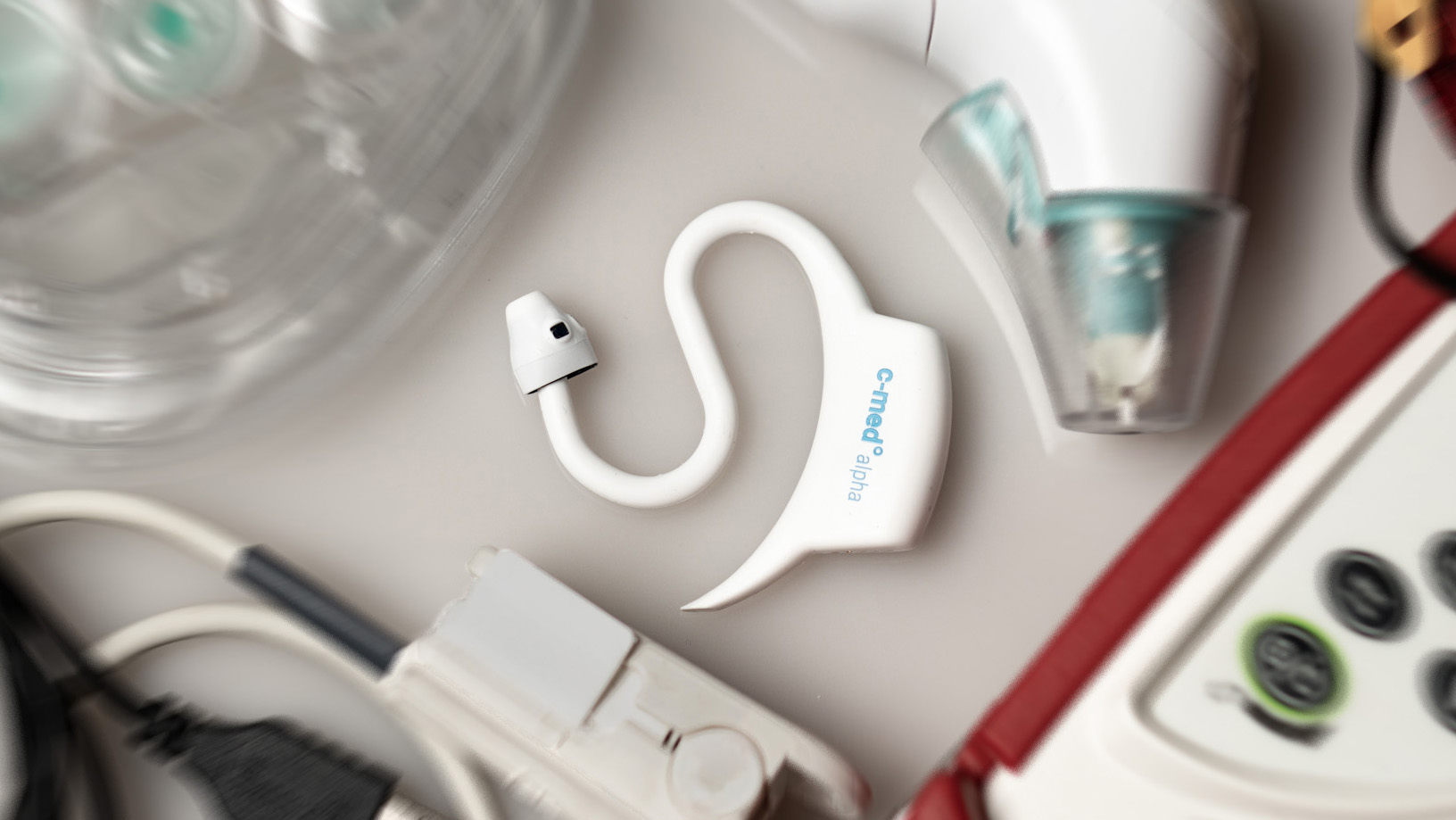
The c-med°alpha in-ear sensor continuously measures pulse rate, oxygen saturation (SpO2) and body temperature.
Can you tell us something about the planned study in which you would like to use the c-med° alpha?
The aim of the study is to investigate whether the c-med° alpha can be helpful in sleep diagnostics with the services it offers. First of all, we would like to use the in-ear sensor with our patients in the sleep laboratory and compare the results with the standard of polysomnography. The most important question here is sleep apnea diagnostics, in which two central parameters are relevant: Oxygen saturation and pulse. We want to find out whether the in-ear sensor measures the oxygen saturation dips just as precisely as the devices in the sleep laboratory and whether the pulse is comparable as a stable parameter. This raises the question of whether the in-ear sensor can serve as a screening tool for sleep apnea. Of course, a c-med° alpha cannot completely replace the sleep laboratory, but we want to see whether it works in a similar way to polygraphy, but with fewer parameters. Another point of comparison is the in-ear sensor in relation to the finger clip. Initial test measurements indicate that the measurements are comparable.
A second question concerns the PPG signal: Can we derive the sleep stages from it? This will probably require an AI solution. But this is a well-known and established procedure, so we are confident that it will work well.
In addition to the questions mentioned, you would also like to investigate the circadian rhythm in the study. Can you tell us more about this and explain why measurement with the c-med° alpha could be helpful here?
There are certain parameters that the sleep laboratory could measure, but which are not particularly practical. In addition to temperature, another example is blood pressure, which is measured either invasively via an artery or with a cuff that pumps every five to ten minutes. Nobody can sleep this way. Indirect measurement via the PPG, on the other hand, would be very beneficial and important, not only for sleep apnea, but also for cardiovascular diseases in general. Normally, blood pressure should drop during sleep, but if it is too irregular, this is an important parameter that should actually be measured, but often isn’t.
Another important parameter is core body temperature, with the emphasis on “core” – it is the temperature inside the body, not the temperature on the skin. Normally there are two ways of measuring this in the sleep laboratory: either a stomach tube or a gut tube. However, these methods are not practical for outpatient examinations, which is why most sleep laboratories, including ours in Großhadern, do not measure core body temperature. Yet it is a very important parameter for assessing the sleep-wake rhythm. When falling asleep, the body lowers various functions, which also lowers the temperature. After about two thirds of sleep, the temperature reaches its daily minimum. It then rises again when you wake up and reaches its maximum in the evening before you fall asleep. These fluctuations are around 0.5 to 1 degree and are consistent for everyone. Measuring core body temperature is therefore a standard examination for sleep-wake rhythm disorders, but is not easy to perform due to the invasive methods involved. The sleep profile is not only relevant for the investigation of sleep-wake rhythm disorders, but also for insomnia. The in-ear sensor from cosinuss°, which has been proven to measure core body temperature, would therefore be an ideal measurement method that is unique to date: a non-invasive method. This is a big plus point, especially if you can do it at home.



